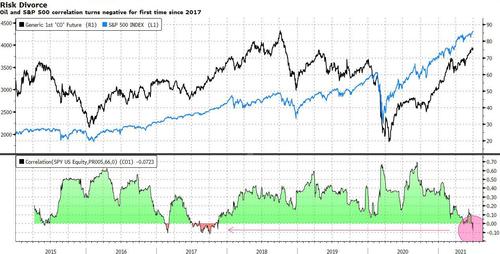Unstoppable Oil Could Be Nail In Coffin For Stocks
By Kriti Gupta, Bloomberg reporter and macro commentator
Stock investors worried about inflation should pay close attention to the rising price of oil. It could be the final kick needed to derail the consumer-spending spree behind the U.S.’s surging growth. From groceries to housing materials to gasoline, life is getting expensive for the average American, even those lucky enough to hold on to their jobs through the pandemic.
Take food. In the last six months alone, the Bloomberg Agriculture Subindex has risen 20% — a margin not seen since 2010-2012. That was when the world’s supplies were roiled by a series of global weather events, including a severe U.S. drought and a massive Russian fire that destroyed some of the nation’s grain crop. Countries where bread is a staple, like Egypt and Tunisia, were hit badly. Geopolitical analysts say it helped set off the Arab Spring.
Not that anything so dramatic seems to be building up. But it’s worth realizing the real-world consequences of climbing raw material prices like we’re seeing right now.
Oil prices have returned to levels last seen in 2018 before the trade war with China began. In the first half of 2021, oil rose 45% on the heels of a gain of some 26% in the six months before. It’s now around $75 a barrel and strategists and trading houses are predicting it will hit $100. As much as it may help producers, it’s bad news for consumer-driven economies like the U.S.
That’s where it matters for stocks. Consumer spending is already moderating and the effects of the fiscal stimulus will likely roll off by September-end. Rising prices from groceries to gas will likely result in less spending and traveling. And that means less revenue — and likely earnings — for many segments of corporate America.
Concerns about that very dynamic can already be seen. Consider the 66-day correlation between the S&P 500 and Brent crude. It’s traditionally positive because oil demand tends to come arm-in-arm with strong economic growth, which also fuels the stock market. But it’s negative, something we haven’t seen since 2017.
When those two markets decoupled the last time, oversupply was the overarching concern for crude during a three-year period that saw strong global growth. It was also President Trump’s first year in office, with his pro-growth and tax-cut agenda boosting the market. Inflation worries existed then, too, with the Federal Reserve picking up its tightening pace. But “transitory” referred to price drops, not rises.
If that correlation remains negative given the market narrative, the best signal for the downside of stocks may be the upside in commodities.
Tyler Durden
Fri, 07/02/2021 – 08:10
via ZeroHedge News https://ift.tt/3dErFDc Tyler Durden
